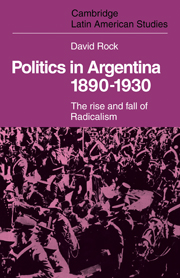Book contents
- Frontmatter
- Contents
- Preface
- 1 The components of Argentine society, 1890–1914
- 2 The oligarchy and institutional reform, 1880–1916
- 3 The rise of Radicalism, 1891–1916
- 4 The workers and their politics in Buenos Aires, 1890–1916
- 5 The first Radical government, 1916–22
- 6 The strikes, 1916–18
- 7 The Semana Trágica
- 8 1919
- 9 Postscript to the first presidency, 1920–2
- 10 The Alvear interlude, 1922–8
- 11 Yrigoyen's second presidency, 1928–30
- 12 Perspectives
- APPENDIXES
- 1 The occupational and class structure of the male population of the city of Buenos Aires by nationality, 1914
- 2 The rise of Radicalism – an historiographical note
- 3 The first Radical government and the Argentine Rural Society
- 4 The working class vote for the Radical and yrigoyenista parties in selected areas of Buenos Aires, 1912–30
- Select bibliography
- Index
2 - The rise of Radicalism – an historiographical note
Published online by Cambridge University Press: 04 August 2010
- Frontmatter
- Contents
- Preface
- 1 The components of Argentine society, 1890–1914
- 2 The oligarchy and institutional reform, 1880–1916
- 3 The rise of Radicalism, 1891–1916
- 4 The workers and their politics in Buenos Aires, 1890–1916
- 5 The first Radical government, 1916–22
- 6 The strikes, 1916–18
- 7 The Semana Trágica
- 8 1919
- 9 Postscript to the first presidency, 1920–2
- 10 The Alvear interlude, 1922–8
- 11 Yrigoyen's second presidency, 1928–30
- 12 Perspectives
- APPENDIXES
- 1 The occupational and class structure of the male population of the city of Buenos Aires by nationality, 1914
- 2 The rise of Radicalism – an historiographical note
- 3 The first Radical government and the Argentine Rural Society
- 4 The working class vote for the Radical and yrigoyenista parties in selected areas of Buenos Aires, 1912–30
- Select bibliography
- Index
Summary
Until recently, studies of Radical populism were mainly of a superficial polemical character. There is no shortage of literature, but much of it has only limited uses for historical research. This appendix contains a brief review of some of the more recent analytical works, which hopefully will allow for a clearer definition of some of the issues and controversies, and help stimulate further research and criticism.
A significant first contribution in the 1950s was the work of John J. Johnson. He regarded Radicalism as the vehicle of the Argentine ‘middle sectors’, whose role he saw essentially as comparable with that of the middle class in Europe and the United States. The questionable assumption of this view is that it raises connotations of the ‘bourgeois revolution’, characteristic of industrial society. The Argentine urban middle class was not an industrialising bourgeoisie, but more a dependent appendix of the primary exporting economy. Rather than opposing agrarianism, the urban middle class supported it, mainly for reasons of consumption. Thus neither the rise of Radicalism, nor the revolution of 1930 can be interpreted, I would argue, as a struggle between industrial and rural interests. The importance of this point is that it expresses the key difference between the conventional industrial society and the pluralist primary exporting society. Contrasting economic structures have their complement in differing forms of social and political development. In Argentina the political integration of the urban middle class was achieved without any challenge to the agrarian–commercial structure.
- Type
- Chapter
- Information
- Politics in Argentina, 1890–1930The Rise and Fall of Radicalism, pp. 279 - 287Publisher: Cambridge University PressPrint publication year: 1975

